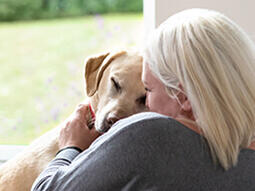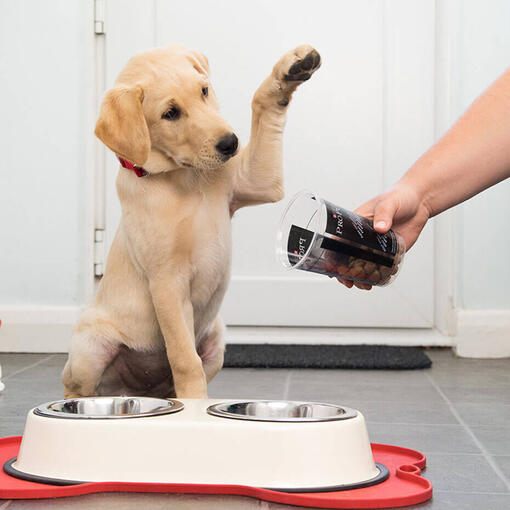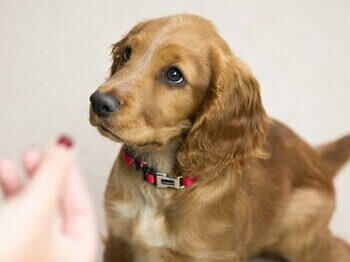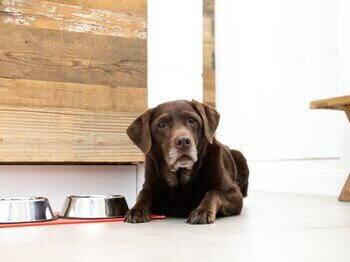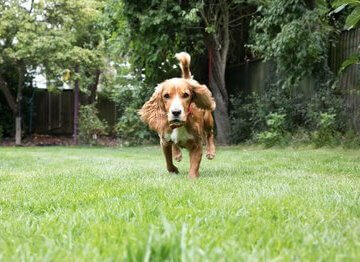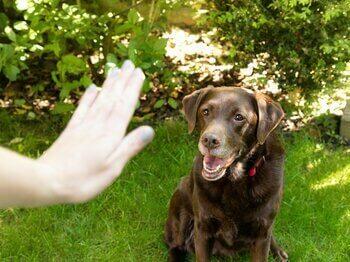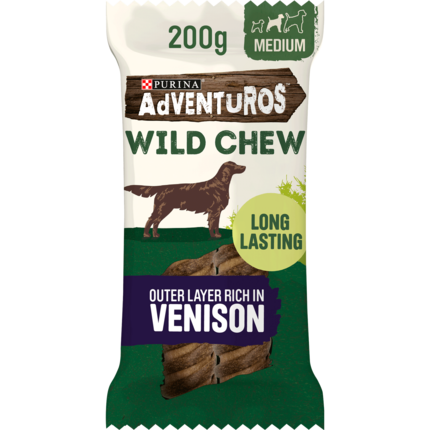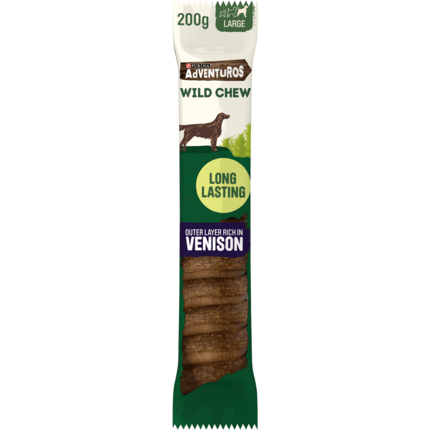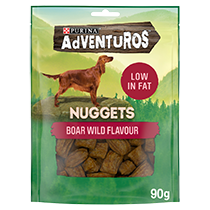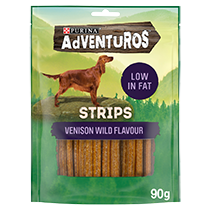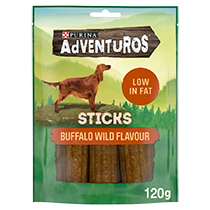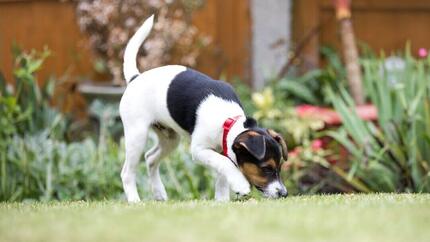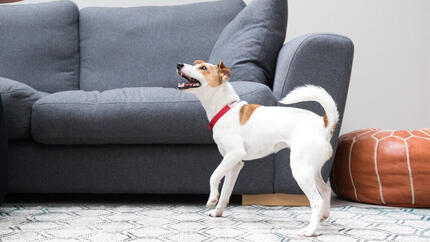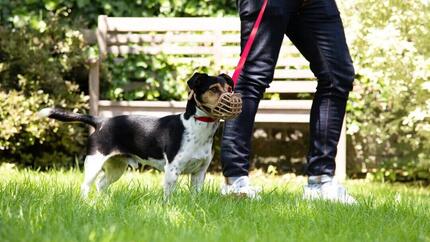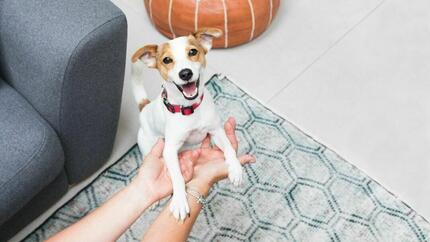


Basic dog training is a fun and rewarding experience for both of you. It’s important to begin training your dog at an early age to get the foundations right before your puppy grows into an adult dog. Find out how to teach your dog basic exercises in our guide.
Dogs are fast learners, and with your loving guidance, teaching life skills such as toilet training and sleep training, as well training your dog how to ‘come’, ‘sit’, ‘stay’ will nurture your relationship as well as encourage good behaviour. Well-trained dogs are less likely to stray, and generally have more freedom and fulfilling lives compared to their untrained counterparts.
Young puppies make eager pupils, so you can start with basic dog training as soon as you get them home. It’s a myth that pups need to be at least six months old before they can be properly trained – the younger they are, the easier it is to teach them. Think of them as little furry sponges, waiting to soak up all the learning you can give them!
Here you’ll find lots of advice on the basics of dog training. For more detailed and advanced dog training advice or to find a good training class, contact a professional accredited trainer.
- Keep puppy training sessions short and sweet. Young puppies lose concentration easily, so it’s better to do six five-minute sessions each day than one half-hour session.
- Only have training sessions when you’re in a good mood. Dogs are very receptive to human emotions, so they’ll be able to tell if you’re stressed or grumpy.
- Always train on a nonslip floor. It can be scary to learn to sit and lie down when you’re trying not to slide.
- Always finish dog and puppy training sessions on a high with an exercise you know your dog can do easily so you end with success.
- In the beginning train with no distractions. Get the basics down in a quiet setting before adding distractions later, so your dog gets used to a variety of environments.
- Have a reward word that indicates that your dog has done what you asked and that a reward is coming (a clicker can be used in the same way).
- Training must always be reward-based, so use lots of toys, treats to help your dog understand what you want and to reinforce good behaviour. Negative or punishing techniques are cruel and will damage your relationship. Never use aversive equipment such as choke chains, prong collars or shock collars as not only are they inhumane and unnecessary, but they can cause lasting physical and behavioural problems.
- Once your dog has got the hang of an exercise and can do it everywhere and at any time, you can reduce the number of rewards you are giving them and even swap food-based treats for toys.
Now that you have all of the tools and rules for basic dog training, you can get started!
An important life skill, as well as a valuable means of improving your connection, is being able to get your dog to give you their attention – so they are ready for anything else you are going to want them to do. This is the perfect first step to any exercise you want to teach, is the foundations for teaching a reliable recall and also goes a long way to ensuring your dog gets into the habit of checking in with you frequently when you are out and about.
- This is something you can do in the house – even when you are watching TV. Fill your pockets with healthy treats that your dog loves. And wait until your dog is relaxed and just hanging out with you.
- Quietly but brightly say their name when your dog turns to look at you, you're your reward word and throw a treat away from you. They’ll find the treat (a fun game in its own right!) and when they’ve found it and eaten it, they’ll look at you again. Repeat. This a few times until your dog gets the hang onf this fun new game.
- Then start to do it in every room in the house, in the garden – and eventually, when they become an expert, while you are out on walks.
- YWith time and practise, your dog will become quicker at looking at you and will be far more focussed on you – as you are a great person to keep an eye on!
- As your dog checks in more regularly, you can gradually increase the distractions and keep practising while your dog is on a harness and long-line in an open space, until you’re ready with reliable recall and your dog can go off-lead.
Practise this several times on every walk. Say your dog’s name and as soon as they look at you, give them a treat – then carry on with your walk.
Sitting on cue is something that we all expect our dogs to do but how many of us have spent the time training this cue so that it’s reliable whenever and wherever you ask?
It’s never too late to teach your dog to sit so let’s get started.
- When your dog is standing calmly, hold a treat near their nose so they can smell it and know that it is there.
- Hold the treat near your dog’s nose and move your hand slowly upwards and slightly backwards so their nose follows.
- As your dog follows your hand and raises their head, their bottom will go down. The second that happens, use your reward word give them the treats.
- Keep practicing this until your dog sits as soon as you start to lift your hand.
- When they are doing this reliably, you can add the word ‘sit’ as they’re moving into the sit position. By doing this you are linking the word ‘sit’ in your dog’s mind to the action of putting their bottom on the floor.
- When you think your dog has associated the word with the movement, you can ask them to sit without the lure of a treat.
- If they sit, praise and reward them. If they don’t, you tried to go onto the next step too quickly., Don’t worry, just go back a step and give them a bit more time to learn the new behaviour.
- At this stage, keep rewarding your dog – every time you give your dog a treat, it reinforces the behaviour. There is time to reduce the treats once your dog has really.
- Once your dog will sit when you say the word ‘sit’, you can start to practise this in different locations. This can be different rooms in the house, in the garden, in the park, on walks etc until your dog will sit wherever and whenever you ask them.
- Some breeds find sitting uncomfortable (such as long backed sighthounds) and so for them, it is better avoided and teach a down as a first exercise instead.
This is another basic training exercise that can be really useful for your dog to know. Here’s how to teach your dog to lie down on cue:
- Hold a treat in your hand so your dog knows it is there.
- Then place your hand flat on the floor with the treat underneath it. Your dog will try every which way to get at it!
- Eventually, they’ll lie down. The moment they do, praise them using your reward word and immediately give them the treat.
- Keep practising , and as soon as they’ve learned that your hand on the floor means ‘lie down’, you can add the verbal cue ‘down’ when they do the action.
- With practice, they’ll be able to lie down on request, without you needing to lure them with the treat.
Now you can start to practice in different locations and eventually with distractions.
If you use the word ‘down’ when you want your dog to lie down, be careful you don’t then confuse them by saying down when you want them to get off furniture or from jumping up. On those occasions use a different word such as ‘off’.
There is a difference between ‘stay’ and ‘wait’ so it is important for you to understand which you are teaching your dog and be consistant.
- Stay = stay where you are until I come back to you.
- Wait = wait where you are until I release you or call you to me.
Let’s start with how to teach your dog to stay and in order to work on this, you’ll need to have a reliable ‘sit’ or ‘down’ cue.
- Ask your dog to sit or lie down (whichever position they prefer) and instead of rewarding them immediately, count to two in your head. Then give your reward word and the treat.
- Keep practising until you can count to four or five before praising and rewarding your dog.
- Now, go back to counting to three after asking your dog to sit/lie down but after three, shuffle your feet a little bit, then praise and reward your dog for staying where they are. If they don’t stay where they are, try again but be much more subtle in your movements and work up from there.
- Keep repeating that, counting between one and five and doing something slightly different each time with your feet.
- Once this is reliable, you can step away, just with one foot to begin with. Praise and reward your dog when you step back to them.
- Keep working on this until your dog is relaxed with the movements and happy to stay where they are. Now that they’ve got the hang of this, you can introduce the cue ‘stay’ or whatever word works for you – as long as you know what you’re asking of them. Go back over the steps using the cue to ask your dog to ‘stay’ before counting, shuffling or moving away.
- You have the start of a reliable stay and now you need to increase the distance between you and your dog before you start to do this in different places and from there, increase the distractions.
- This is a difficult exercise for many dogs, as up until now, we have wanted them to stay with us and follow us. It is one to take really slowly and use lots or praise and rewards.
Don’t start practising the ‘wait’ until you have a reliable ‘stay’ and your dog understands the cue (and don’t train both at the same time as it can get really confusing for your dog).
- When you’re ready to start teaching a wait cue, follow the same steps but instead of coming back to your dog, recall them to you and praise/reward them when they come to you at each step.
- This is a really useful cue to teach a dog for when they are in the car and you don’t want them to jump out, or at a door or gate. However, there is always the temptation of the ‘great outdoors’ so always err on the side of safety.
If your dog is walking towards the chocolate bar you have left on the table or the medication you have dropped, can you confidently ask them to 'leave it' and be sure that they’ll know what you're asking of them?
Training your dog to leave it could save their life, so in this article we have six easy-to-follow steps.
Over the next couple of weeks, when you’re relaxing with your dog, try these steps and it won’t be long before your dog understands what you mean by the cue ‘leave it’.
Step One:
- Hold a small piece of food in your fist so that your dog does not have easy access to it.
- Slowly extend the food towards your dog’s nose and let them work out how they are going to get it out of your hand. They’ll probably try smelling, nibbling, or pawing at the treat.
- Eventually they will back away slightly to have another think about how to best get it. They instant they make any motion to move their head away, praise them with your reward word and give them a piece of food from your other hand. It’s important that the reward comes from the other hand so your dog doesn’t learn to go back to the thing you’re asking them to leave!
- Repeat this exercise a few times until your dog consistently makes the decision to take their nose away from the food and get rewarded from the other hand.
Step Two:
- Now add the words ‘leave it’ while your dog is in the act of moving their head away. This builds up an association between the cue and the action.
- Repeat this process a number of times. It doesn't matter how long it takes; every dog learns at a different pace some might take a few minutes while others might take a few weeks!
- Once your dog can do this reliably, ask them to ‘leave it’ as soon as you present your hand to them; then reward them (from the other hand) for moving their head away.
Step Three:
- Put the food in your open palm so that your dog can see and smell it.
- Show your dog the food in your open palm and ask them to ‘leave it.’ in the same quiet voice you have been using. ‘Ask’, don't shout!
- If your dog tries to eat it, just close your hand. Try again, but if you need to do this more than twice in a row, go back a stage… it just means that you’ve moved on a bit too fast, and your dog needs more practice.
Step Four:
Only move on to this when your dog is reliably responding to the words in step three.
- Put the food on the floor and ask your dog to ‘leave it’.
- Repeat the process, rewarding your dog with a treat in your hand, not the one on the floor.
Step Five:
- Put your dog on their harness and lead and walk past the treat on the floor with them.
- As your dog looks at it, say ‘leave it’ without pulling on the lead, then praise and reward your dog with a treat from your hand when they walk past it. If they grab the treat, don’t try to get it out of their mouth or tell them they've done something wrong; they haven't. Go back to the previous stage where your dog was successful and practise some more until they are ready to move onto this next stage.
Step Six:
- Keep repeating the exercise by placing other objects on the floor – preferably the types of things you want your dog to leave alone. Don’t practice with your dog's toys… as this can be confusing for your dog.
- If you find your dog on piece of furniture they are not allowed to be on, say ‘off’ and encourage them to come to you.
- When they come ‘off,' reward them calmly with praise and a treat.
- If you do have ‘no go’ places for your dog, consistency is important. If one member of the family turns a blind eye to the house rules or if you sometimes let them do it for a treat, you've had it!
If they growl at you for attempting to remove them, back off, and seek the help of a qualified behaviourist via your vet’s referral as soon as possible. Don’t attempt to tackle any aggression problems yourself, as you may make things worse.
This cue is one to practice so that it can help you and your dog get out of a situation quickly if you need to. For ‘let’s go’ to become an automatic response,and something your dog responds to immediately, it’s going to take some practice.
Just as with any other cue, you need to start somewhere with limited distractions. You’ll need your finest treats and your finest high energy voice.
- As you’re walking, without pulling on the lead, turn in the opposite direction and encourage your dog to turn and walk with you, offering praise and rewards.
- You’ll need lots of energy and your dog’s favourite treats because this has to be to be something that’s instilled as an instinctive a cue for your dog to follow. Imagine you’re creating the walkies equivalent of opening a packet of biscuits. You know that the sound of that packet opening means you have your dog’s full attention. That’s the sort of response you’re looking for.
- After a few turns with high energy, fun and your dog’s favourite treats, start introducing the ‘let’s go’ cue as you turn and your dog comes with you.
- Practice, practice, practice. Keep it fun, keep the rewards coming and make sure your dog knows that at the sound of ‘let’s go’ they don’t need to look around, they don’t need to hesitate, they just need to be with you.
Vary the distraction levels and soon, you’ll be ready to try when you’re out and about. The reason it’s important to practice this often is so that your dog doesn’t think twice when they hear that cue. That means, for example, if you see someone in the distance that you’re not sure they’ll want to meet, you can say ‘let’s go’ and your dog is ready to turn and walk with you at speed. They don’t do it because you have the treats with you there and then, they do it because of the hundreds of times you’ve played this game before, great treats have come their way.
Always consult your vet if you have any concerns about your pet’s health, as they can recommend individual advice or treatment options. For detailed behavioural advice tailored specifically for your pet, we suggest you contact a qualified pet behaviourist.
Looking for advice on how to train an older dog, or learning more puppy training skills? Read our guides, next!

